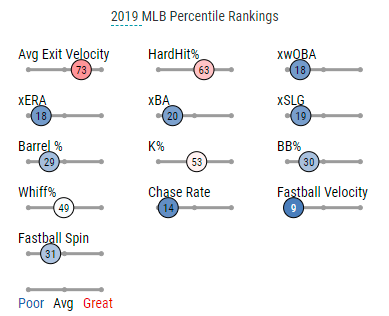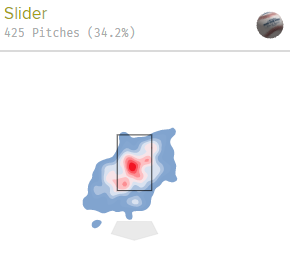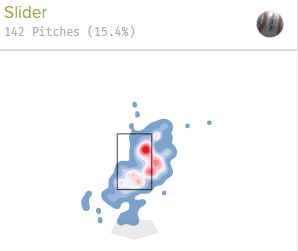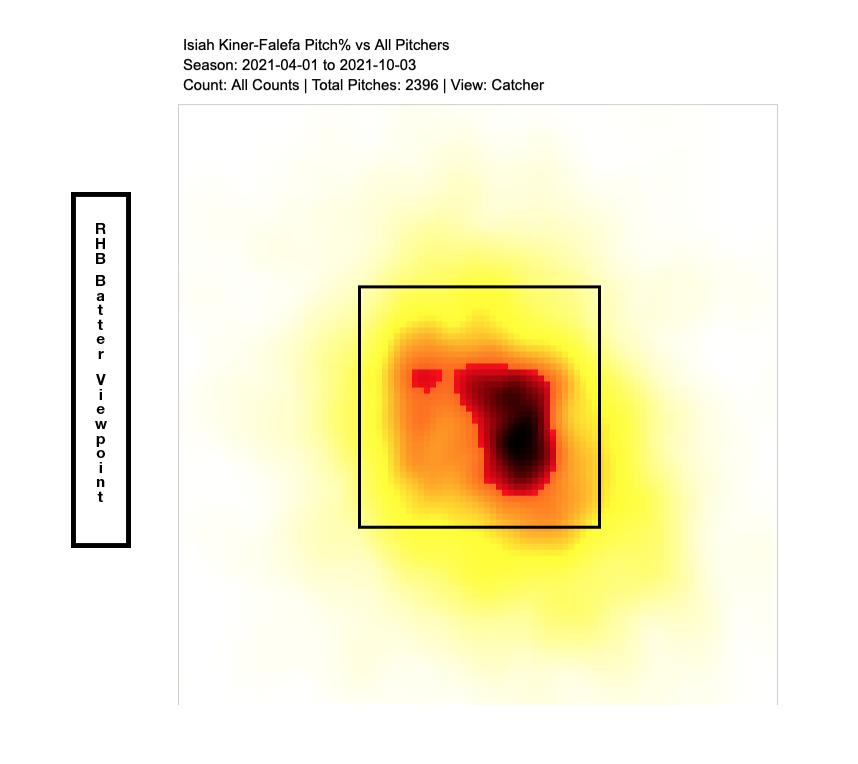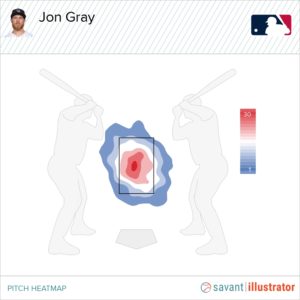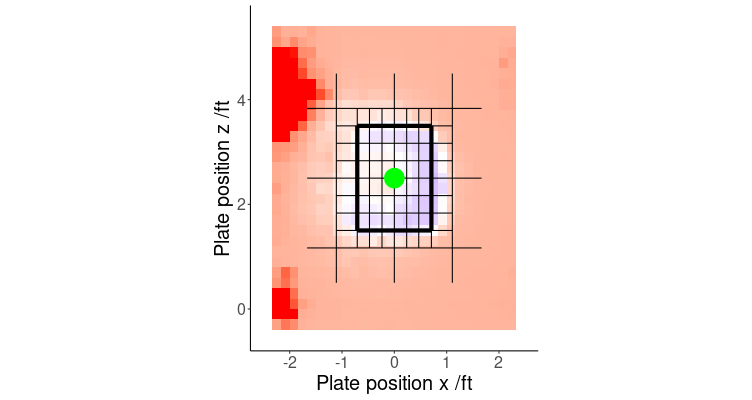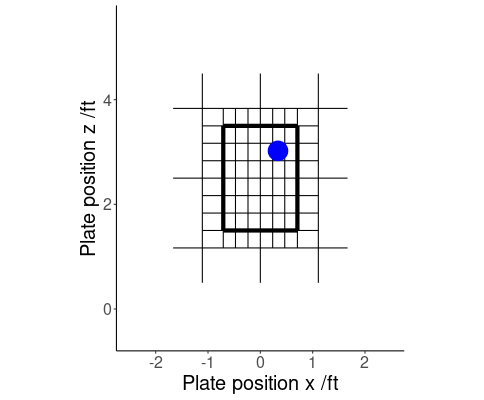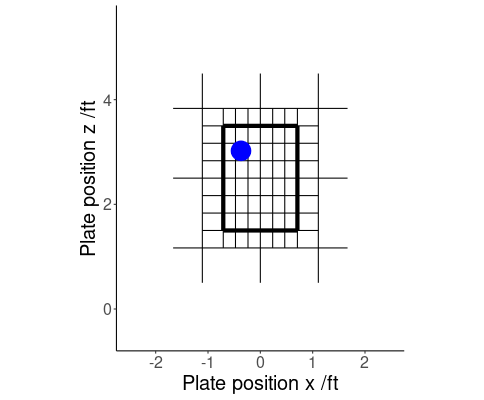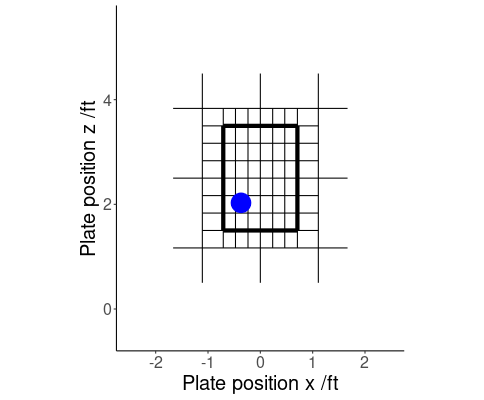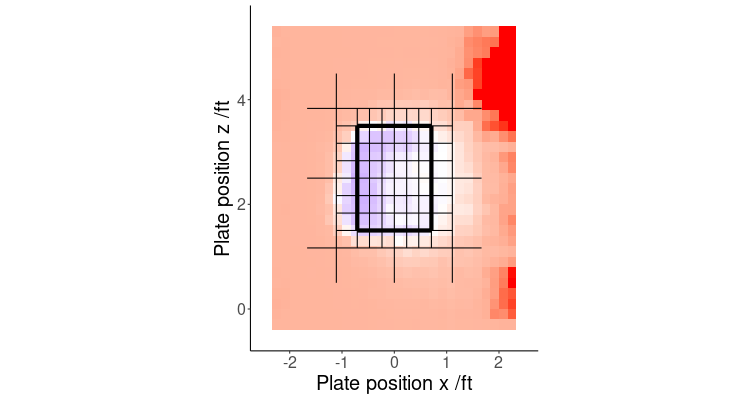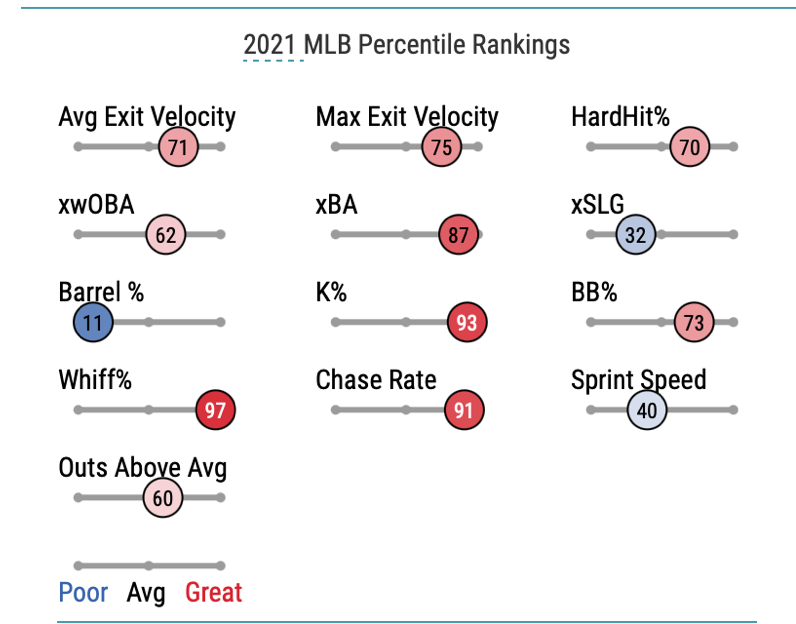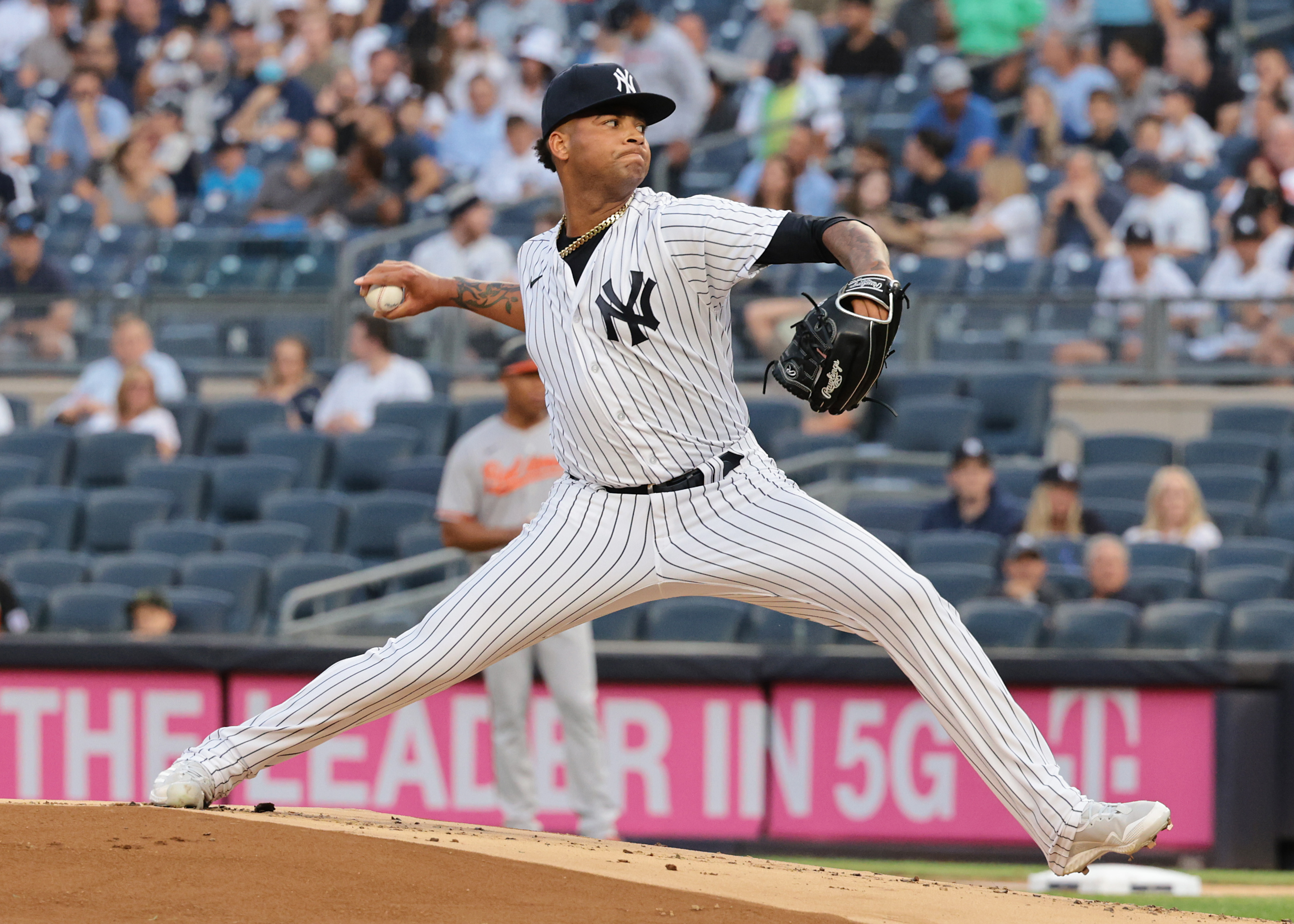The post How Aaron Judge can catch and pass Roger Maris for the Yankees home run record appeared first on Bronx Pinstripes | BronxPinstripes.com.
]]>
CHASING HISTORY
#YANKSonYES pic.twitter.com/G3xSz3k0sY
— YES Network (@YESNetwork) August 10, 2022
The Yankees have 50 games remaining on the slate. Half of those games are at Yankee Stadium. Among the 25 road contests, 18 are in ballparks in the top 10 for home runs this season.
So, can Judge reach the mark and if he does, how far does he go?
I’m estimating that the Yankees will give him three (maybe four) days off, in addition to the five scheduled days off. A couple of tough factors to measure are how meaningful the games will be and how much of a sense of history the team has in allowing him to pursue the record.
Below are my projections for Judge at each spot on the remaining docket.
Yankee Stadium 25 games:
Judge has 110 career home runs at home. He homers once per every 10.9 at-bats. If we assume he plays 25 games and gets four at-bats per game, that’s 100 at-bats, and if you divide that by 10.9, that’s a little above nine home runs. He’ll have plenty of familiar at-bats against division opponents plus six games against the Minnesota Twins and Pittsburgh Pirates. It’ll probably be higher but I’ll go with nine.
Fenway Park five games:
Judge has five career home runs at Fenway Park. He homers once per every 27.6 at-bats there. If he plays all five contests and gets four at-bats per game, that’s 20 at-bats, and if you divide that by 27.6, that’s 0.72. It’s a bad pitching staff and an ideal ballpark for a righty but I’ll be conservative and give him one.
Ring Central Coliseum (Oakland) four games:
Judge tears up A’s pitching in Oakland and that was before they stripped down their roster. Judge has four home runs in 43 at-bats at Oakland or one per every 10.75 at-bats. If he plays them all and gets 16 at-bats, he projects to hit 1.48. So, I’ll give him two home runs here.
Angel Stadium three games:
Judge has two home runs in 47 at-bats here. That’s one homer per 23.5 at-bats. If you give him 12 at-bats, that translates to 0.51. The Angels have a lousy pitching staff but I’ll play it close to the vest and give him one.
Tropicana Field three games:
Judge has eight home runs in 148 career at-bats at the Trop. That’s one homer per 18.5 at-bats. He’ll probably get at least one rest day on the turf, so let’s say he gets eight at-bats. That translates to 0.43. I’m actually going in the other direction and I’m giving him two home runs here.
American Family Field (Milwaukee) three games:
Judge has never played at Milwaukee but in 2022 the ballpark is the fifth friendliest for home runs in MLB. I’ll give him two here.
Rogers Centre (Toronto) three games:
Judge has 11 career home runs in Toronto in 122 career at-bats. That’s one home run per 11.0 at-bats. Let’s say he takes a day off from the turf, even though it’s late in the season. So in eight at-bats, that translates to 0.72. I’ll give him one home run here.
Globe Life Park (Texas) four games:
In 14 at-bats at Globe Life Field, Judge has zero home runs. It’s the final series of the year, it’s a turf field and the Texas Rangers have a bad pitching staff. So, let’s say he plays three games, gets 12 at-bats, and hits two home runs.
In total, that’s 20 home runs in the remaining 50 games, good enough for 65 overall. Hence, at that number, I already have him with 63 home runs headed into the Texas series, meaning he’d potentially tie the mark at Toronto and perhaps break it at Yankee Stadium against Baltimore, and oh wouldn’t that be fun?!
The post How Aaron Judge can catch and pass Roger Maris for the Yankees home run record appeared first on Bronx Pinstripes | BronxPinstripes.com.
]]>The post Remember when Nestor Cortes stunk? appeared first on Bronx Pinstripes | BronxPinstripes.com.
]]>- Throw more innings.
- Give up fewer runs.
- Grow better facial hair.
This is like saying robbing a bank is as simple as going into the building and walking out with a bag of money, but that’s equivalent to what Cortes has accomplished. From 2018-2020, he surrendered 62 runs in 79 innings. Since 2021, he has only allowed 43 runs in 153 innings, including just 11 in 60 this season.
He accrued most of his ugly early-career numbers as a member of the 2019 Yankees. Nestor wasn’t a memorable member of that 103-win club, but he threw 66.2 innings over 32 relief appearances and one start. He posted a 5.67 ERA that season with 16 home runs allowed. His 2.2 HR/9 was the second-worst in MLB among qualified relievers. The Statcast percentile rankings weren’t pretty:
His pitch arsenal wasn’t quite the same as it is now. Notably absent was his devastating cutter, which he throws 40% of the time in 2022. He didn’t incorporate that pitch until last season. He primarily featured a four-seamer/slider/changeup mix in 2019. His slider in particular illustrates the difference between control and command. Here’s his slider heat map from 2019:
By contrast, this is where he locates his slider in 2022:
Having control is merely the ability to avoid walks. Cortes did that in 2019 but frequently left pitches in the middle of the plate which could be blasted over the fence. In 2022, he displays outstanding command by dotting the outside corner against right-handed hitters. Here’s an example of what happened to those middle-middle hanging sliders in 2019:
Of course, it wasn’t just the slider’s fault. When he threw this 88 mph fastball in Rougned Odor’s wheelhouse, it landed 440 feet away for a grand slam:
This changeup down the pipe hardly moved at all, which might be why he barely ever throws it these days:
We’re all grateful Cortes isn’t that guy anymore. The new-and-improved Nestor locates his pitches in places that are nearly impossible to hit. That’s why his WHIP dropped from 1.55 in 2019 to 0.87 this year and his home run rate is more than three times lower.
Of course, the real major change he made was the mustache. He just doesn’t look right clean-shaven, but it was still better than whatever this was:
Orioles Return Rule 5 Pick Nestor Cortes To Yankees https://t.co/92sp4pPgWK pic.twitter.com/8xgfOKzqsZ
— MLB Trade Rumors (@mlbtraderumors) April 14, 2018
The new Nestor is here to stay. As long as he keeps locating his pitches flawlessly on the outside corner, the only questions will be whether or not he should start the All-Star Game and if he can win the Cy Young.
The post Remember when Nestor Cortes stunk? appeared first on Bronx Pinstripes | BronxPinstripes.com.
]]>The post Clay Holmes has become an elite reliever appeared first on Bronx Pinstripes | BronxPinstripes.com.
]]>When the Yankees acquired him from the Pirates for a pair of punchless minor league utility infielders— Diego Castillo and Hoy Park— they couldn’t have imagined his immediate metamorphosis into a right-handed version of peak-Orioles Zack Britton. In his 49.2 IP as a Yankee since the trade last July, he has a 1.09 ERA, a 0.75 WHIP, and 55 strikeouts. Most importantly, he has walked just six batters after giving out 84 free passes in 119.2 IP with Pittsburgh.
The most obvious change he made was eschewing his worst pitch. Early in the 2021 season, he featured his curveball almost about as much as his slider. When he joined the Yankees he ditched the pitch almost entirely. In 2022, he has thrown only three of them all year. Instead, he has bumped his sinker usage up from about 50% to around 75%.
His power sinker has developed into one of the single most effective pitches in MLB. It averages 96.3 mph and dives in on right-handed hitters. It generates a healthy amount of whiffs, but its real superpower is getting groundballs. Batted balls have an average -14 degree launch angle against the offering. An absurd 83.3% of all batted balls against him this year have been grounders. No other pitcher’s groundball rate is even as high as 70% (minimum 10 IP), and the single-season record is 80% (2016 Britton).
While his sinker is his bread and butter, his slider plays off of it beautifully. Along with several other Yankee hurlers, he reworked his slider grip this spring to generate more horizontal movement:
The #Yankees sacrificed 2 mph of velocity to pick up 6" of horizontal movement on Clay Holmes' slider between 2021 and 2022.
How? They flipped him to a 2-seam SL grip.
Swinging strike rate on the pitch went from 17%
31%. pic.twitter.com/OMqRIFKggy
— Lance Brozdowski (@LanceBroz) May 12, 2022
Holmes’ radical transformation since joining the Yankees has turned him into one of the best relievers in MLB. Through Saturday, he has faced 78 batters in 2022. 21 of them struck out, two walked, and one was hit by a pitch. Of the 54 who put the ball in play, 46 hit grounders. As a result, he has allowed only two extra-base hits all year, both of which were doubles.
The most inexplicable change of all is his lack of free passes. With the Pirates, he either walked or hit 17.6% of opposing hitters. With the Yankees, he only gave up walks or HBP to 3.9% of batters faced. Hitters know they can no longer be passive and wait for him to fall behind in the count or throw ball four. Now they have to be aggressive or risk a called strike three. This causes them to swing at less delectable pitches, bumping up his whiffs and generating weak contact.
There’s more than one way in which walk rate led to his move into the closer role. Aroldis Chapman hasn’t technically blown a save yet this year, but he was bombed in a tie game yesterday. his walk rate is up to 15.2%. Perhaps it’s even more concerning that his strikeout rate is down to 22.7%, which is right around league average. For reference, his career strikeout rate is 40.7%— second-best in MLB history trailing only Craig Kimbrel.
The coinciding of Holmes’ rise and Chapman’s decline led to a natural passing of the torch. Aroldis’ problems are a subject for another day, but the Yankees are in excellent hands with Holmes no matter which inning they use him.
The post Clay Holmes has become an elite reliever appeared first on Bronx Pinstripes | BronxPinstripes.com.
]]>The post Jameson Taillon is making adjustments appeared first on Bronx Pinstripes | BronxPinstripes.com.
]]>A heavy flyball pitcher, a below average strikeout pitcher, and someone who would walk the league average amount of batters; it simply was not going to work. In 2022 however, Taillon has seemed to put something together to curb his shortcomings in velocity due to his extensive injury history.
Dealing With Lefties
Taillon 2021 walked lots of left-handed hitters, and that was due to a lack of weapons to deal with them.
Taillon’s FF was largely successful vs lefties, but his curveball and slider remained ineffective, and the more you use a pitch in a count, the worse your pitch sequencing is, making Taillon susceptible to late count damage. His stats against lefties were not just underwhelming; they were downright awful.
5.21 FIP
5.29 xFIP
11.8% K-BB%
While Taillon did have his changeup in 2021, it performed poorly (.376 wOBA, 2.7 RV/100). In 2022, the changeup improved dramatically (.000 wOBA, -6 RV/100). Taillon’s changeup is a legitimate weapon, and a high 35.3% Whiff Rate means Taillon can keep lefties off guard while having his typical great fastball mix.
A new weapon in his arsenal is his cutter, a pitch that is solid stuff and command wise (55/80). The pitch has a mere .261 xwOBA against with a 21.0% whiff percentage against. His cutter initially was used only against lefties, but the pitch was used against righties in Toronto, though this sample is still small. How has this affected Taillon’s numbers versus lefties? Well they’re slashing just .176/.222/.294 with a 3.17 FIP and 3.56 xFIP. His 21.1% K-BB% is great, and he’s truly showing that he not just put them away, but over power them with his solid stuff and impeccable command.
Attacking the Zone
Easily the biggest change Taillon has made that has excited me is his willingness to just attack batters. He’s lived in the zone, and has walked under 2% of batters so far. That won’t hold up over a full season, but his hyper-aggressiveness is nice to see.
The command has graded out superbly, with a -0.63 Command xRV/100, giving Taillon a 70/80 grade according to PitchingBot. Throwing just 64 balls, it means he’s thrown 83.1% of his pitches for strikes, a remarkable amount. His stuff isn’t stellar, but it’s certainly strong enough to allow him to live in the zone without getting hammered, something Taillon struggled with last year. He’s going to throw the kitchen sink at batters with cutters, sinkers, sliders, curveballs, changeups, and four-seamers, and he’ll be able to do so in the zone.
Going Forward for Jameson Taillon
Taillon is giving up a lot of hits as a result of his high contact rates against, but his WHIP at 1.14 isn’t impossible to work with. So far he has held batters to an under 1.1 HR/9 rate (1.06) which is also a nice sign of his ability to limit hard contact. Getting barreled at under a 5% clip is phenomenal, and when you walk no one and strike out over 20% of batters, you’re hitting benchmarks for success. That being said, Taillon has to figure out a way to consistently get himself past the 5th inning if he wants to be more than a 4-5 starter.
Taillon has 2 starts where he couldn’t get through 5 innings this year and only 1 where he recorded more than 5 IP. On the surface this seems to be an insignificant talking point, but that’s truly Taillon’s biggest limiting factor. He has the pitch mix, command, and the requisite stuff. Now it’s a matter of proving you can be a pitcher that the bullpen doesn’t need to bail out. He showed this against Toronto, and hopefully that’s a stepping stone Taillon builds on going forward.
The post Jameson Taillon is making adjustments appeared first on Bronx Pinstripes | BronxPinstripes.com.
]]>The post The rise of IKF appeared first on Bronx Pinstripes | BronxPinstripes.com.
]]>A name many Yankees fans wanted to steer clear of this past offseason, especially considering Carlos Correa, Corey Seager, and Trevor Story were readily available. And their disdain towards IKF seemed to be justified in the early going. He had a wRC+ of just 74 through the first nine games of the season. Small sample size, yes, but it was not looking great for the former Ranger and Twin (for a hot second). Just for comparison, in his first season as a Yankee, Didi Gregorius had a paltry wRC+ of 11 through his first nine games. Many liken the IKF trade to the Didi trade: both were not known as being great all-around shortstops.
But Didi quickly enamored himself with Yankees fans, and IKF has done the same in the past week or so. What’s changed?
Pulling the ball?
IKF’s pull rate has shot up.
|
Season |
Pull % | Center % | Oppo % |
|
2021 |
31.6 |
38.5 |
29.9 |
| 2022 | 42.6 | 31.9 |
25.5 |
His pitch heat maps from the past two seasons are not significantly different. In fact, he received a higher rate of pitches on the inner half of the plate last year than has this year.
So why is this a good thing? It actually might not be. IKF is hitting .263 on pulled pitches this season versus .346 in 2021. Where he’s really making his money this year is going up the middle and the other way. Ironically, he’s been doing less of it than last season, but he’s hitting .458 on those batted balls in 2022 compared to .299 in 2021.
Statcast stats
If we take a look at his Statcast stats, IKF is seeing a good amount of red (which is a good thing).
Everything has gone up:
|
Season |
Exit Velocity (MPH) |
Launch Angle (degrees) |
Hard Hit Rate |
XBA |
XSLG |
|
2021 |
85.5 | 5.4 | 28.8 | .267 | .349 |
|
2022 |
89.8 |
6.4 |
43.2 |
.300 |
.434 |
| Change | +4.3 | +1.0 | +14.4 | +.033 |
+.085 |
(One thing that’s a bit shocking is his 13.3 strikeout rate last season was in the top five percent in the league. It’s up to 19 percent this year and it’s not in the top five percent. That may tell you a little something about how the season has started for teams around the league.)
In addition, IKF has become a better hitter with two strikes. We saw it last weekend with him doubling in the game-tying run against Emmanuel Clase’s 100.3 miles per hour up-and-in fastball. Against fastballs with two strikes, IKF is hitting .471 this year compared to just .243 last year.
As seen above, his launch angle has increased. Even if it is a modest increase, he is hitting fly balls with more authority now to the tune of a .300 batting average on such balls, compared to a paltry .135 in 2021.
All in all, I will admit it is a small sample size from 2022 to compare to a full 2021 season. However, IKF has the makings of being another Didi, and so far he’s won back the fans after a slow start.
The post The rise of IKF appeared first on Bronx Pinstripes | BronxPinstripes.com.
]]>The post Checking in on bounce-back candidates appeared first on Bronx Pinstripes | BronxPinstripes.com.
]]>LeMahieu
Going into Thursday’s game, LeMahieu was hitting .294 with a wRC+ of 191 Last year, he hit .268 and was a league-average hitter (100 wRC+). Late last season it was revealed he was playing with a sports hernia, although he did play in 150 games. Even with a small sample size, what do the Statcast numbers look like?
|
Season |
Exit Velocity |
Barrel % | XBA | XSLG | XWOBA |
Hard Hit % |
|
2021 |
90.6 |
3.7 |
.283 |
.397 |
.340 |
43.5 |
| 2022 | 91.2 | 15.4 | .324 | ..697 | .477 |
61.5 |
The 2022 XSLG, XWOBA, and hard-hit rate put him in the top nine percent of the league. Yes, it’s early, but it is definitely encouraging to see DJ barreling pitches and hitting them hard. He may never regain his 2019-2020 form, but him being a well above league-average hitter will do wonders for this lineup.
Gallo
Gallo has certainly run into some bad luck in the first week of the season. Going into last night’s game, he was hitting only .188 but has an XBA of .310. Check out where he ranks in a bunch of different categories:
We all knew his strikeout rate was going to be high and we have to live with that. But Gallo is someone who easily can launch 40 home runs in the middle of the lineup. If he continues hitting the ball the way he has been, those balls will start finding grass or sailing over the wall. So while the standard numbers are not super appealing, fans should be happy with the underlying numbers from his first week.
Torres
Gleyber hit .300 in 2021 with a 124 wRC+ when he played second base. Now that he’s back there nearly full time, hopefully his entire game becomes more comfortable for him. One aspect of his game that fans are clamoring for is his power. He hit 24 homers as a rookie in 2018 and followed that up with 38 in 2019 before hitting a combined 12 home runs in 2020 and 2021. Over the last two years, he was hitting fewer fly balls and more ground balls. With that, his slugging took a nosedive.
His average launch angle across the 2018 and 2019 seasons was 18.2 degrees, while it was 14.4 for 2020 and 2021. This year it’s up to 16.9 so far, which is a good sign.
I know it’s only been a week, but the underlying numbers for guys who need a bounce-back season are looking pretty decent so far. Let’s see if they can keep it up and wins back some fans in the Bronx.
The post Checking in on bounce-back candidates appeared first on Bronx Pinstripes | BronxPinstripes.com.
]]>The post Jose Trevino: A Yankee deep dive appeared first on Bronx Pinstripes | BronxPinstripes.com.
]]>Jose Trevino’s Offense (Or Lack Thereof)
Trevino is by all statistical regards a bad hitter. A 66 wRC+ hitter, Trevino struggles to get on base (.270 OBP), slug (.364 SLG), or hit for average (.245). His splits are even as well, with a 65 wRC+ vs RHP and 67 wRC+ vs LHP. His baserunning is also awful too, with a -5.5 BsR, ranking him as the 8th worst baserunner in the sport last year minimum 300 PAs. No matter how you slice it, Trevino is just bad on that side of the ball, however that seemingly detrimental aspect of his game hasn’t prevented Trevino from being a valuable catcher.
Best Defensive Catcher in Baseball?
Trevino’s defensive excellence is statistically as good as it gets. His volume wasn’t very high last season and yet he was able to rank near the top in some of the most in-depth defensive metrics for Catchers.
8.8 FRM (3rd)
11.6 FRAA (3rd)
14.7 CDA (3rd)
0.018 CSAA (3rd)
FRM is a simple framing metric found on Fangraphs.com, and FRAA (Fielding Runs Above Average), CDA (Catching Defensive Adjustment), and CSAA (Called Strikes Above Average) can be found on BaseballProspectus.com. FRAA and CDA give us a general glimpse of a catchers’ defensive output, and CSAA and FRM give us strong idea as to how good that catcher is at stealing strikes, which is something that greatly helps pitchers.
For as bad as Trevino’s offensive value is, his defensive value is unreal. When you’re better than Kyle Higashioka defensively, you’re unreal. In terms of Baseball Prospectus Wins Above Replacement Player (bWARP), he was 14th among catchers. This was just in 302 PAs, and he was tied with Willson Contreras, who’s considered to be an All-Star. At a 2.1 bWARP, he would’ve led all Yankee catchers in bWARP last year too. However you slice it, he’s a good catcher all things considered, but what about Ben Rortvedt?
Giving the Youngster Time
Ben Rortvedt is someone I like, but he struggled against MLB competition in 2021. He was 23 for most of the 2021 campaign, and looked rightfully overmatched. In AAA he can continue to develop that 50-grade raw power. If he ever figures out how to have that raw power translate to the MLB level, he could probably figure out how to have an OPS that’s above .700 with really good defense, which is a good catcher.
Rortvedt has time to perform without pressure and with someone to have to earn a spot over. Now, he suddenly has a better trajectory for his own progression as a player.
Ultimately, the Yankees got a good catcher in Trevino, and they didn’t give up more than they should’ve to stabilize themself as the best defensive catching team at the MLB level in 2022.
The post Jose Trevino: A Yankee deep dive appeared first on Bronx Pinstripes | BronxPinstripes.com.
]]>The post Luis Gil isn’t far from greatness appeared first on Bronx Pinstripes | BronxPinstripes.com.
]]>He showed flashes of brilliance, and while he’s still a work in progress, Gil isn’t too far from becoming a great pitcher. The fastball has strong qualities, his slider is already elite, and his changeup is a few tweaks away from being a good third pitch. While he is the farthest thing from a sure thing, he can be the next breakout star in baseball.
Luis Gil’s Stuff Vs Command Struggles
A metric I’ve used a lot for pitchers in xRV/100 (Expected Run Value per 100 Pitches) from Cameron Grove’s Pitching Bot. Gil’s xRV/100 on his FF was a sound -0.34. Graded as a 70 Stuff Grade FF, it’s an elite pitch in spin, velocity, and movement. The problem comes with its lackluster 45 command grade, and that issue is what defines Gil’s struggles.
His slider and changeup have 60 and 65 stuff grades but only have a 50 and 45 command grade each. It highlights the fact that the talent is there to be a three-pitch starter, but the consistency needs to develop. Unfortunately, the lockout may hamper the ability of the Yankees staff to address this.
When it comes to command, it seems like Gil can never figure it out. Maybe he’s just never going to become a great pitcher or even a good one. That being said, there’s a pitcher who profiles extremely similarly to Gil, someone who could be used as an example for Gil’s development.
Taking A Page From Freddy Peralta
Freddy Peralta put together an incredible season for the Brewers, being a slept on No. 3 starter behind the ferocious duo of Corbin Burnes and Brandon Woodruff. With a 4.0 fWAR and 2.81 ERA, Peralta managed to rank top 20 in fWAR among starters with 140 or more IP. How do Gil and Peralta compare? Let’s look at their prospect grades.
| Category | Freddy Peralta | Luis Gil |
| Fastball | 60/60 | 60/70 |
| Slider | 55/55 | 55/60 |
| Changeup | 40/45 | 30/40 |
| Command | 40/50 | 35/40 |
| Overall | 45 | 45 |
Gil boasts the better fastball and slider while Peralta has the better changeup and command, but just like Gil, Peralta had walk issues in the minors and majors. He hasn’t had a below 9.6% BB% at the MLB level, yet is one of the 20-25 best pitchers in the sport.
Gil can build off of Peralta’s development, with both having 80-85% spin efficient 4-seam fastballs that have a rising and cutting effect. Their wipeout sliders are also similar, and it was Peralta’s ability to develop his other pitches that allowed him to excel as a starter. Peralta does have a curveball (something Gil does not have), but Gil’s changeup is pretty promising stuff wise.
Such a changeup comes in with such velocity that it’s lackluster movement doesn’t matter much. How does one exactly hit a 90 MPH changeup? Maybe he should dial it down a bit from 92-93 in order to have more velocity difference, but if he can ramp up the heater to 98-100 that 90 MPH changeup is disgusting.
The Case To Be Great
Gil has the stuff to be great; and ultimately that’s the biggest step towards greatness. Command is something organizations can figure out and can be developed. You can’t teach a guy to have an elite fastball and slider.
Gil’s changeup was considered a pitch without much future; yet it boasts a strong stuff grade. His slider proved to be a weapon with little big league development. Most importantly, he is a few tweaks away from having one of baseball’s best fastballs. Is it super spin-efficient? No, but with some cutting action perhaps that helps him versus left-handed hitting (Taillon’s fastball has similar cut and found great success vs LHH).
Ultimately, deviation from the norm is what pitchers want, and Gil is different. He throws freakishly hard, has a top 30 slider in the sport, and boasts an abnormally fast changeup. The kid’s got the potential to become one of the best in baseball.
Hopefully he has a strong spring training and he earns a shot to be in that rotation, because I think Luis Gil is going to be a top-of-the-line starter someday.
The post Luis Gil isn’t far from greatness appeared first on Bronx Pinstripes | BronxPinstripes.com.
]]>The post Aaron Hicks: The biggest X-Factor for the Yankees appeared first on Bronx Pinstripes | BronxPinstripes.com.
]]>I was one of the biggest Hicks supporters coming into the year, raving about his offensive excellence and his consistency at the plate.
That took a turn for the worst in 2021, with Hicks struggling and getting hurt. His 76 wRC+ and .294 OBP were his lowest marks as a Yankee since he first came over in 2016.
That being said, his struggles were entirely different, and I’d say that his 2021 was a blip in the radar. That being said, Hicks is without a doubt the biggest question mark on this roster, and he’s going to be the biggest X-Factor for the Yankees in 2022.
Should Aaron Hicks Still be the Yankees Center Fielder?
He had a horrible 2020 defensively, posting -8 DRS, a -11.6 UZR/150, and -4 OAA. Mind you this was only in 54 games, so I’m quite worried about his defense going forward. He had a positive OAA and UZR this year, but it’s a small sample size and could be an outlier.
But his arm is still pretty good, having the 14th best ARM in 2020 for outfielders, and I think he could really thrive in a corner outfield spot. His range isn’t what it once was, and Joey Gallo can slot into CF perfectly. He has 4 DRS and a 13.4 UZR/150 out there, and with his 120-130 wRC+ bat he would immediately become a top 5-6 CF.
Hicks profiles well in LF, and could stay healthier with less ground to cover. He can have spot starts in CF, but he shouldn’t be the starter.
The Yankees could also add someone like Seiya Suzuki and make Hicks a rotating 4th outfielder, getting reps in all 3 outfield spots as everyone rotates between the OF and DH spots.
That added insurance can guarantee the Yankees have at least 3 starting caliber outfielders on the roster at all times. Yes, Hicks is more of a corner outfielder now and he’s injury prone, but that doesn’t make him bad. Hicks’ offensive talent is often underplayed, and I think that should be corrected.
Yes, Aaron Hicks is a Good Hitter
Hicks has some of the best plate discipline in the entire sport. He boasts a mere 18.4% O-Swing rate since 2019, the 13th lowest in the sport. The only batters with a higher barrel and lower chase rate are Mike Trout, Juan Soto, Max Muncy, Mitch Garver, and…Clint Frazier. Here are their wRC+ numbers since 2019:
Mike Trout: 175 (1st)
Juan Soto: 159 (2nd)
Mitch Garver: 135 (22nd)
Max Muncy: 130 (39th)
Clint Frazier: 110 (128th)
While Clint is the obvious outlier here, Hicks is doing something that only the elite hitters in baseball do;
Rarely chase and hammer the pitches they swing at.
Hicks did that really well from the right-side of the plate in 2021, pulling the ball 52.2% of the time with his high launch angle, allowing him to slug a whopping .545.
He was way less disciplined, with a sub 6% BB% and above 30% K% from the right side, but the pull rates from his left side were way low. He pulled the ball 38.6% of the time from the left handed side, and while opposite field groundballs are good, opposite field flyballs are not.
His walk rate will always be around 10-15%, it’s just a matter of doing damage with pitches in the zone. He had a .334 xwOBA in 2021, so it wasn’t like he wasn’t posting a strong quality of contact, it just wasn’t optimized properly from the left-side.
There’s a lot to like about Hicks’ offensive game, but do projections see the same thing?
What To Expect From Hicks In 2022
While the answer “expect the unexpected” is rather accurate for Hicks, it’s boring. We have publicly available projection systems that can account for a lot of variables with a player. Steamer is my personal favorite due to the fact that it has a strong correlation with next year wRC+, and Hicks does pretty well with Steamer. Here’s how Steamer thinks Hicks will do in 2022:
583 PA
.233/.346/.413
.332 wOBA
111 wRC+
2.5 fWAR
All things considered, that’s a pretty reasonable projection for Hicks, and it’s a pretty solid season. The best bet for the Yankees is they grab another outfielder who can start and play CF as well (SEIYA SUZUKI PLEASE) and Hicks rotates in and out of the lineup. Switch hitting outfielders with great plate discipline are valuable, but Hicks shouldn’t be depended on to play 150 games either.
If Aaron Hicks takes on Gardner’s role, the Yankees are going to have a loaded outfield for 2022, and it’ll provide fans and most importantly the Yankees a much less stressful season.
The post Aaron Hicks: The biggest X-Factor for the Yankees appeared first on Bronx Pinstripes | BronxPinstripes.com.
]]>The post The Yankees could turn Jon Gray around appeared first on Bronx Pinstripes | BronxPinstripes.com.
]]>He posted a 4.59 ERA in 2021, which is right around a league average adjusted ERA for Rockies starters. Gray truly wasn’t very impressive, and yet he’s a starter constantly linked to the Yankees. He isn’t a bad starter, but is he a difference-maker? Matt Blake has turned the pitching development around a lot in the Bronx, and that opens up questions about if Gray could turn it around in the Big Apple. When you delve into his repertoire, he has a lot more value than meets the eye.
So, how could Gray help the Yankees?
What About Jon Gray is Already Very Good?
The very first thing that stands out aboutGray is his slider, a pitch that has boasted stellar results.
| wOBA | xwOBA | K% | Whiff% | RV |
| .254 | .235 | 37.4% | 38.8% | -13 |
Jon Gray, Filthy Sliders (helicopter sword & bend the knee).
pic.twitter.com/5NoZrW5paC
— Rob Friedman (@PitchingNinja) April 4, 2021
This pitch has been his bread and butter, a signature pitch of his that he’s used with a long track record of success. Its -13 RV ranks as the 9th best slider in all of baseball, and out of all pitches, it’s the 43rd best pitch in baseball out of 2388 different pitches.
Gray also boasts a 48.4% GB%, ranking him 23rd in groundball rate among 115 starters with 100 or more innings. His mere 6.9% barrel rate against and solid 15.4% K-BB% allowed him to boast a 4.04 xFIP, 3.98 xERA, and 4.17 SIERA, which are above average. With that being said, let’s now get into what’s held Gray back.
The Areas of Concern
To go alongside one of the best sliders in baseball, Gray boasts one of the worst four-seam fastballs in baseball.
| wOBA | xwOBA | K% | Whiff% | RV |
| .404 | .362 | 15.9% | 17.4% | 16 |
That is what we like to call, not very good. His 16 RV makes it the 4th worst fastball in baseball, and the 6th worst pitch in all of baseball
Yikes.
How does a fastball that clocks in at nearly 95 MPH struggle so much? Gray’s fastball has a problem; it has the 16th lowest vertical movement out of all four-seam fastballs. Coupled with a mere 2,152 RPMs, his four-seamer seems like it’s not ever going to be a good pitch, right?
Well thankfully, there’s a template for pitchers with low spin and negative vertical movement four-seamers. Aaron Nola of the Phillies struggled ERA-wise, but he posted a 3.26 SIERA, and has a 3.54 ERA since 2017, and his four-seam fastball has similar spin and movement properties as Gray’s.
While not entirely comparable, it’s fair to say that if Gray can just boast an average fastball, he’d become a pretty good starter for the Yankees, but what changes are necessary to make that happen?
Jon Gray’s Changes Going Forward
This is how Gray located his fastball in 2021, going in the heart of the zone too much for comfort. Here’s how the Pitch Tester would recommend he throw his fastball instead.
The blue highlights where he should throw his fastball, taken from the catcher’s perspective. That means that the right side is the 1st base side, and the left is the 3rd base side.
As you can see, they want him throwing away to right-handed batters more and inside to left-handed batters more. Does this reflect exactly how these batters did against him? Not really, since here’s how RHHs and LHHs did versus his four-seamer.
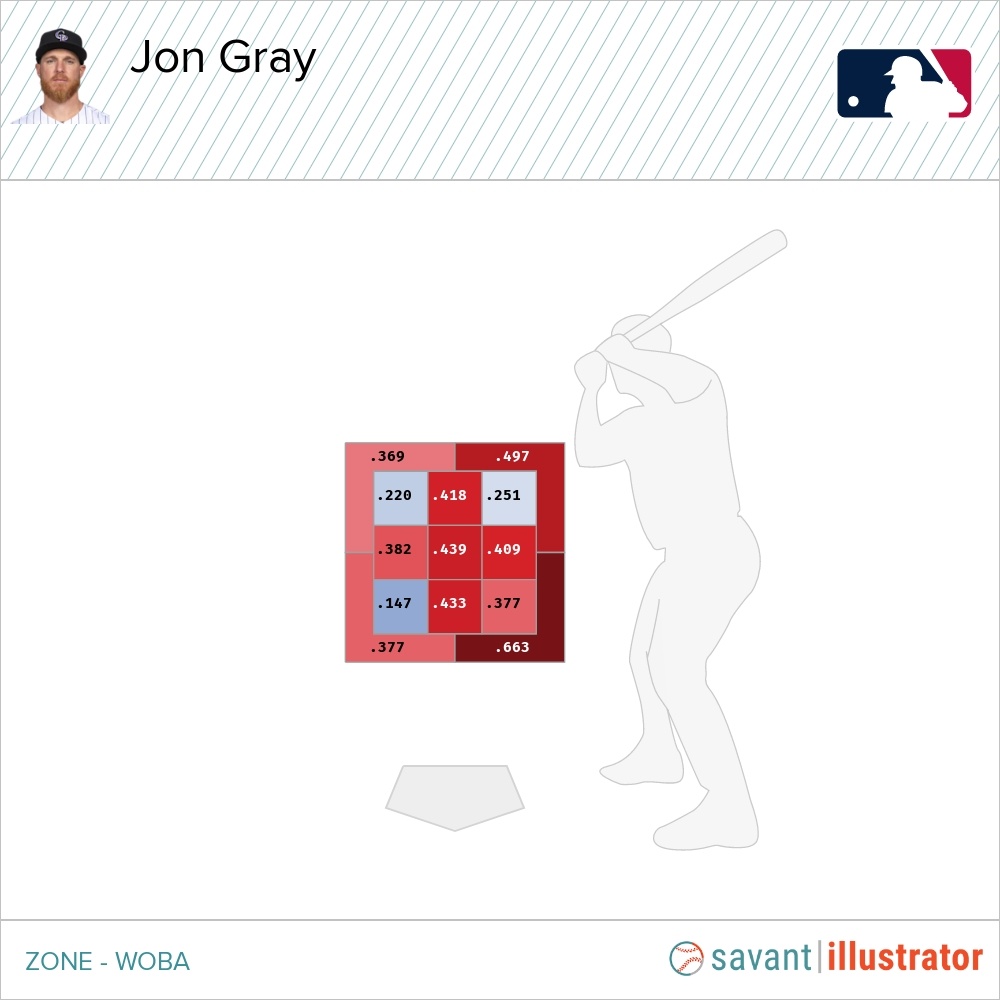
The first image is vs LHH, the second vs RHH. Left-handed hitters seem to just Gray’s number, crushing his fastballs in all areas except for a few pockets.
Versus right-handed bats Gray seems to dominate on the upper half of the plate, holding them to a wOBA way below .300. While there isn’t a consensus “best way to fix his fastball”, there is a definite conclusion to be drawn that Gray needs to avoid the heart of the plate more.
His fastball doesn’t have the capabilities to be a high whiff pitch, and using it to get groundballs and called strikes should be vastly more effective for Gray.
What To Expect From Jon Gray
His pitch mix is all over the place, but the talent is there. A pitcher who can generate a good amount of groundballs while throwing a hard fastball with a good slider is always valuable. Steamer seems to also like Gray, giving him some favorable projections:
| ERA | FIP | xFIP | fWAR |
| 4.13 | 4.08 | 4.04 | 2.4 |
Steamer projections serve as baseline projections, meaning that his median outcome is being a solid 3-4 starter. His upside screams potentially being a #2 starter, and there’s a lot of reason to believe he could have that unlocked here.
After all, he’s coming from Coors Field and from a dysfunctional Rockies organization. If he can recapture his 2016-2019 form, Jon Gray could definitely elevate the Yankees rotation in 2022.
The post The Yankees could turn Jon Gray around appeared first on Bronx Pinstripes | BronxPinstripes.com.
]]>The post The case for the Yankees to bring back Masahiro Tanaka appeared first on Bronx Pinstripes | BronxPinstripes.com.
]]>Cashman was even quoted saying, “There’s no door closed, let’s put it that way from my perspective.” Tanaka expressed his interest in returning to the Yankees, and I think the biggest reason he didn’t was due to monetary constraints. I don’t think Masa is an elite starter, but he’s a lot better than most FA options. This is a weaker starting pitching market, and Masahiro Tanaka could provide the Yankees a ton of value if he were to return.
The Surface Stats Aren’t The Full Story
Masahiro Tanaka’s 2019 and 2020 seasons were not spectacular when grouped together. Let’s look at how he stacks up against the pack in ERA, FIP, xFIP, and SIERA.
ERA-: 94 (57th/106)
FIP-: 93 (51st/106)
xFIP-: 94 (46th/106)
SIERA: 4.39 (51st/106)
Well, it seems like Tanaka can’t really provide much more value than being an average starter. Among pitchers with 150 or more innings from 2019-2020, he’s right in the middle of the pack in all park-adjusted ERA, FIP, xFIP, and in SIERA. Seems like he shouldn’t get much of a market from the Yankees, but what if I were to tell you there’s more to dig up for Tanaka? Let’s introduce you all to Expected Run-Value.
Expected Run-Value and Why You Should Use It
This is not as much of a metric as it is a model. Developed by Cameron Grove, it aims to predict what a pitch in a certain location based on many different factors should result in. These outcomes range from swinging strikes to line drives to foul balls.
The model takes this information from every pitch said pitcher has thrown in a season and creates an Expected Run-Value for the pitcher and each of their pitches. Negative Run-Value means you’ve thrown a good pitch, positive run-value means you’ve thrown a poor one. It’s rather accurate with Run-Value, which is a metric on Baseball Savant that can be found here! We’re trying to see if a pitcher’s repertoire should have a high success rate, and that can play a huge role in how we value a potential diamond in the rough.
As for any other questions about Expected-Run Value that I could not answer, Cameron Grove wrote an entire article detailing the metric. You should check it out and support his work, he does phenomenal stuff. We have less sophisticated data than ones used within MLB organizations, but the Yankees could definitely have some data that thinks highly of Masahiro Tanaka as well.
Tanaka’s Incredible Potential
Tanaka’s 2019 was one of his worst, posting his 2nd worst ERA-, worst SIERA, and worst xFIP-. Despite that, he had the 19th best xRV/100 among ALL pitchers in baseball. That even includes relievers, totaling 702 pitchers. He took a step back in 2020, but he still was incredibly impressive in his xRV. Here’s how he stacks up in xRV and his overall pitch grade.
| Year | xRV | Overall Grade |
| 2019 | -0.79 | 70 |
| 2020 | -0.42 | 60 |
For Overall Grade, it’s scaled the same way scouts grade tools, which is on a 20-80 scale. Masahiro Tanaka’s Splitter, Slider, and Curveball are all graded extremely well in this model, but I think the X-Factor here is his fastball.
Tanaka’s fastball has been putrid when batters make contact with it, as it has an over .400 wOBA against every year since 2017. That’s…not good to say the least. He can be much more than a pretty solid starter if he were to even have an average fastball. The Yankees were able to turn around Nestor’s fastball completely, and if you compare the properties of both Tanaka’s fastball and Nestor’s there are some striking similarities.
| Player | CSW% | Active Spin | RPM | MPH | Extension | Vertical Movement |
| Masahiro Tanaka | 26% | 96% | 2231 | 92.3 | 6.1 inches | 15.3 Inches |
| Nestor Cortes Jr. | 28.8% | 93% | 2224 | 90.7 | 6.0 inches | 14.7 inches |
Both differ in location, but they throw from different arm angles and one is a lefty and the other a righty. Not really the fairest comparison, but still worth a look. Why don’t we try to predict where Tanaka’s fastball would have the most success based on 2021 data?
Playing a Number’s Game
Using Cameron Grove’s Pitch Tester, we can place a fastball with Tanaka’s properties wherever we want in the strike zone and see its expected run-value.
(The graphics are from the catcher’s perspective, so the right side is the 1st base side, the left side is the 3rd base side.)
Based on these four locations which I’ve labeled by Quadrant as 1, 2, 3, and 4, here are the Run-Value results:
| Quadrant | xRV |
| 1 | -1.4 |
| 2 | -2.0 |
| 3 | -2.2 |
| 4 | -1.5 |
What we can conclude is that the average Tanaka fastball would succeed in all 4 quadrants (so it’s a good pitch), but it would work best in Quadrants 2 and 3 most likely. How about against lefties?
| Quadrant | xRV |
| 1 | -1.5 |
| 2 | -3.1 |
| 3 | -3.2 |
| 4 | -1.7 |
Using the same 4 locations (quadrants), his fastball would do incredibly versus left-handed hitters, with it doing extremely well on the 3rd base side of the plate against lefties as well. Let’s look at his fastball heatmap from 2019-2020 however, as it shows that he doesn’t reside heavily on the 1st base half of the plate.
This is his fastball heatmap from 2019-2020, and he’s way too much in the heart of the zone for my liking. Let’s compare it to where his suggested pitch location is:
The blue is where the pitch tester suggests his fastball should be, with the red being where his fastball is less effective. This is a very different heatmap than the one we see for Tanaka, and it could mean that Tanaka’s fastball is simply not being located in the proper areas for success.
Sure, Tanaka isn’t going to be a dominant ace or even a top 25 starter like he was from 2014-2016, but he’s certainly a very solid starter, and we should bring him back.
The post The case for the Yankees to bring back Masahiro Tanaka appeared first on Bronx Pinstripes | BronxPinstripes.com.
]]>The post King and Severino give the Yankees much-needed weapons out of the pen appeared first on Bronx Pinstripes | BronxPinstripes.com.
]]>The big guys
Zack Britton was hurt, struggled, and then got hurt again. Aroldis Chapman started the year being unhittable, but then regressed to a point where he wasn’t even the closer, and now he’s getting back to his true self. And while Chad Green has been solid overall, he recently had a horrendous stretch where he was giving up huge, game-costing home runs left and right.
The bright spots
So who have been the more consistent bright spots? Jonathan Loaisiga for one. He has always had electric stuff but has never been able to put it all together. He had a solid season last year with a 3.52 ERA in 23.0 innings, but he was not an elite reliever. This year, he has been elite, to the tune of a 2.25 ERA in 68.0 innings. His win probability added this year has been 2.91, good for seventh overall among all relievers. He also has a crazy 191 ERA+. But he also recently was hurt with a rotator cuff strain, but thankfully return from the injured list for last night’s game.
The other bright spots are guys who weren’t here to start the season. Clay Holmes (1.44 ERA in 25.0 IP) and Wandy Peralta (3.12 ERA in 40.1 IP) have been dynamite for this bullpen. Here are their ERA+ before and after coming to the Bronx:
| Before | After | |
| Clay Holmes | 86 | 301 |
| Wandy Peralta | 78 | 138 |
Back to King and Sevy
But I’m here to talk specifically about what King and Sevy have added to this bullpen. Especially now with Jameson Taillon probably out for the rest of the year, the length that King and Severino can provide is paramount. King can give you at least two to three innings, and Severino can likely give you another two. Sure, they can’t pitch every day, but with the way the postseason schedule works, you have an off day every two or three games.
If you look at the starting rotation, only Gerrit Cole is a sure bet to be able to give you six or seven innings.
Other guys such as Nestor Cortes, Jordan Montgomery, and Corey Kluber all can pitch well, but realistically how many innings can you get out of them? Four or five? Aaron Boone probably won’t try to push them a third time through the order. So if you could, for example, have Nestor pitch the first four innings, you don’t necessarily have to worry about burning out your bullpen because someone like King can give you three innings to bridge the gap to the late-inning relievers. Then you only have two more innings left to cover! You can use Holmes and Chapman and still have Green and Loaisiga completely fresh for the next day.
So you could essentially piggyback Nestor and Monty with King and Severino and get a good six or seven innings. This allows there to be less pressure on the quartet Holmes, Loaisiga, Green, and Chapman having to routinely get more than three outs. And Wandy’s there too!
Of course, in the playoffs you could have some relievers who are pitching better than others. Maybe Loaisiga doesn’t look the same coming back, although he dominated on Wednesday night. But with Taillon (not anymore) and Domingo German not having a real chance to build themselves back up for the postseason, King and Severino give you real multi-faceted weapons out of the pen. And they have to be an upgrade as a piggyback over J.A. Happ, right?
The post King and Severino give the Yankees much-needed weapons out of the pen appeared first on Bronx Pinstripes | BronxPinstripes.com.
]]>The post What really has gone wrong with DJ LeMahieu, and is he turning it around? appeared first on Bronx Pinstripes | BronxPinstripes.com.
]]>DJ LeGroundout?
Many will point to LeMahieu constantly hitting ground balls. However, so far this season, his ground ball rate of 52.9 percent is below his career average of 53.3 percent. And here’s how it compares to the rates from the past two years:
|
Year |
Ground ball rate (%) |
|
2019 |
50.1 |
|
2020 |
56.6 |
|
2021 |
52.9 |
| Career average |
53.3 |
This year’s rate is not far off from his normal one. In fact, he was hitting more ground balls last season. Is he hitting as many fly balls?
|
Year |
GB/FB |
|
2019 |
1.91 |
|
2020 |
2.68 |
|
2021 |
2.14 |
|
Career average |
2.31 |
So while he did hit a good amount more ground balls in 2020 as compared to 2019, it didn’t hurt his performance at all. Additionally, he is hitting .246 on grounders this year compared to only 1.80 on fly balls. However, his ground ball rate and wRC+ do seem to be negatively correlated. For example, most recently, his ground ball rate has gone down a bit and his wRC+ has gone up.
But some people also point to the deadened balls, and this could make some sense, as his hard hit rate is much lower than in years past:
|
Year |
Hard hit rate (%) |
|
2019 |
40.4 |
|
2020 |
35.4 |
|
2021 |
27.7 |
|
Career average |
31.4 |
Oddly enough, his barrel rate of 2.9 percent was in the bottom nine percent of the league in 2020. This year he is up to 3.6 percent, but it’s still a far cry from the 7.5 percent clip he put up in 2019.
So with the decrease in the amount of balls he hits hard comes the decrease in expected batting average. In fact, all of his expected stats are down:
|
Year |
XBA |
XSLG |
XWOBA |
|
2019 |
0.309 (top 2 percent of MLB) |
0.514 |
0.370 |
|
2020 |
0.308 (top 4 percent of MLB) |
0.453 |
0.361 |
|
2021 |
0.278 |
0.388 |
0.336 |
Pitch selection
There doesn’t seem to be much difference in how pitchers are pitching him in terms of pitch selection. The past few seasons it has been around 65 percent fastballs, 25 percent breaking pitches, and 10 percent offspeed. And DJ tends to do well across the board — in terms of expected batting average. He doesn’t usually have a particular pitch that constantly gets him, as you might think with Giancarlo Stanton and offspeed pitches. However, LeMahieu’s numbers against offspeed stuff this year are down, but the actual numbers are much lower than the expected ones:
| – |
Actual |
Expected |
Difference |
|
BA |
0.161 |
0.267 |
-0.106 |
|
SLG |
0.258 |
0.378 |
-0.120 |
|
WOBA |
0.206 |
0.299 |
-0.093 |
So perhaps he is just running into some bad luck on offspeed pitches. For fastballs and breaking balls, his actual and expected stats are fairly similar.
Turning a corner?
In the month of September, LeMahieu is hitting .319 with a 113 wRC+. Granted, it has only been 13 games and 55 plate appearances, but we know what he is capable of doing. If he keeps up his recent production at the plate, he definitely a valuable player, especially with his +1 OAA this season in the field and ability to play multiple infield positions. Plus, his Baseball Savant summary still looks quite good:
Will he ever live up to his contract? I don’t know, we’ll need a few more years to decide that. But right now, his value isn’t too far off from a $15 million AAV player.
The post What really has gone wrong with DJ LeMahieu, and is he turning it around? appeared first on Bronx Pinstripes | BronxPinstripes.com.
]]>The post Aroldis Chapman’s fastball is no longer special appeared first on Bronx Pinstripes | BronxPinstripes.com.
]]>Fast forward to the present, where he surrendered the go-ahead run in Saturday’s 4-3 loss to the Baltimore Orioles on a sacrifice fly, letting the Tampa Bay Rays further distance themselves in the AL East standings. As with all sac flies, the real story is the lead-up. After Ryan Mountcastle reached on a wild third strike, Chapman threw his legendary fastball for ten of the next 13 pitches. Seven of the ten missed the strike zone, including a pair of bouncers in the dirt. After falling behind Austin Hays 3-0, he pumped one in for a strike… at 95.7 mph.
Not So Fastball
Pure velocity means little without command, which he clearly lacked on Saturday. However, even when he locates successfully, his heater simply isn’t what it used to be. If he threw a pitch less than 96 mph when he first joined the Yankees in 2016, it would’ve been more likely to be some kind of offspeed or breaking pitch. He didn’t throw any fastballs that year at 95.7 mph or lower, though he did hit 94 mph with a slider.
Here’s his average four-seam fastball velocity by year:
His average fastball was 101 mph in 2016. Now it’s 98.6 mph, though he did regain half a tick from his nadir in 2019 and 2020. He’s 33 years old now, and no one can throw that hard forever, but he’s reached the point where his fastball no longer packs the same old sizzle on a consistent basis. He can still touch triple digits, but not as frequently as he used to do. In 2016, 57.8 percent of his fastballs were at least 100 mph, which was easily the highest percentage in MLB. This year, it’s 15.8 percent, sixth-best in MLB. From 2010-2018, he eclipsed 103 mph 270 times while every other pitcher in MLB combined did it only 70 times. Since 2019, he’s only reached 103 twice.
Catching Up
The problem with pushing the upper limits of the human body is that once something is possible, other people start to do it too. Since 2019, 81 pitchers have touched triple digits. Chapman’s fastball used to stand alone on the velocity mountaintop, but now he’s just part of the crowd.
His average fastball velocity this season is 99th percentile, which is still excellent, but there’s a big difference between 99th percentile and 100th. He no longer throws so hard that the opposing hitter will have never seen that type of velocity before. Indeed, fastball velocity around MLB has increased dramatically. Here’s the average MLB fastball velo by year:
- 2016: 92.3 mph
- 2017: 92.8 mph
- 2018: 92.8 mph
- 2019: 93.1 mph
- 2020: 93.1 mph
- 2021: 93.5 mph
A 1.2 mph league-average increase over six years is enormous. While most of the league still can’t catch up with Chapman’s fastball at its best, just about everyone is better than his worst. Even though he tops 100 frequently this year, when he doesn’t have his best heater it’s not much faster than average. He’s thrown 39 fastballs under 96 mph this season. Here’s one he threw only 93.8 mph on July 6:
Even though it was well located, that’s a very hittable pitch, and Seattle Mariners infielder Ty France poked it into right field for a single. Just like every other MLB hitter, he sees 93.8 mph fastballs every day. 637 pitchers have thrown at least one pitch 94 mph or better in 2021.
In his heyday, Champan’s fastball overpowered hitters nearly all the time. He’s still capable of reaching back for that elite heat from time to time, but more often than not, he sits in the high-90s with a few in the mid-90s. 186 pitchers hit 98 mph this year, which is right about where Chapman averages.
Hitting Spots
Let’s revisit Saturday once more when Chapman loaded the bases with no outs in the ninth inning of a tie game. Things went off the rails when he allowed a single to Austin Hays and walked Trey Mancini. There were a few fastballs in that two-batter sequence with mediocre velocity, but that wasn’t the main problem. In fact, he hit 100 mph on the 1-1 pitch to Mancini.
This was the fastest pitch thrown by any pitcher on either team during the game. The problem was that he desperately needed a strike to get ahead of the count with runners on first and second with no outs, but the pitch was low by about six inches.
Chapman’s fastball no longer pops 100 mph as effortlessly as it used to. As a result, he hasn’t located well when reaching back for max velocity. Since July 28, ten of the 16 100 mph pitches he’s thrown have been balls. This is a big reason why he’s walked 32 batters in 45 innings. His 16.4 percent walk rate is his worst since 2011, which was his first full season in MLB.
Failing to throw strikes has other consequences too. Facing Hays, he fell behind 3-0 on three straight fastballs out of the zone. After a called strike on his lowest velocity fastball of the outing, he hung a slider which was deposited into left field for a single. Had he not fallen behind in the count, he would have most likely thrown a less hittable pitch.
Even with an outstanding 39.3 percent strikeout rate and 15.2 K/9, this has been the worst season of Chapman’s career so far. He has allowed more hits, walks, and home runs than usual. His once trusty fastball is no longer the marvel it used to be, and when he fails to throw it for strikes, it’s the culprit of his downfall.
The post Aroldis Chapman’s fastball is no longer special appeared first on Bronx Pinstripes | BronxPinstripes.com.
]]>The post Gleyber Torres: A test of patience appeared first on Bronx Pinstripes | BronxPinstripes.com.
]]>2021 will go down as a lost season for Torres, but does that mean his time in the Bronx should come to an end?
The Reality of Torres’ Ceiling
Torres having a 38 HR season really skewered everyone’s expectations for him. Sure, that’s an impressive HR output, but it only resulted in a 124 wRC+. A 124 wRC+ for a 22-year-old is impressive, but it isn’t generationally great. His ceiling most likely is a 140 wRC+ hitter, which is great for a middle infielder, but a far cry from the MVP talks people had about him. He’s simply not a good enough defender nor powerful enough of a bat to post the 6-7 WAR seasons you see from an MVP.
His 9.4% barrel rate, 7.9% BB%, and 21.4% K% suggested Gleyber Torres had a good power tool alongside solid bat control. With better plate discipline, Torres could become that 130-140 wRC+ he was always projected to be. That was only two short years ago, everything made so much sense with Gleyber then. Why doesn’t it make any sense now? He has great plate discipline with an above 10% BB% and below 20% K% has aged more and should be in theory so much better.
People will point and say it started in 2020, but that’s just statistically untrue.
2020 Was Better Than You Remember
The regular season was a nightmare for Gleyber Torres, posting terrible defensive numbers and a mere 106 wRC+. The alarming part was the 3.7% barrel rate, a career-low even to this day. The postseason for Gleyber Torres was the opposite, posting a 246 wRC+ and a whopping .696 SLG%.
When you add it up, you get a stat line of this for 2020 Gleyber Torres:
190 PAs
128 wRC+
.355 xwOBA
.420 SLG
.391 OBP
The power is still down, a .420 SLG is not at all great, but the .391 OBP, .355 xwOBA, and 128 wRC+ would all be career highs for Torres. He was better than ever in 2020, so should we really let this season be the end of Torres?
The answer is no.
A Light At The End Of the Tunnel
Not that small sample sizes are the end all be all, but Torres has shown encouraging signs as of late.
Let’s look at Torres’ launch angle from 2018-2020 compared to his 2021:
’18-’20: 17.8
’21: 14.7
He’s hitting the ball on the ground this year, not great, but what about recently? In his last 24 games, Gleyber Torres has a 19.2 Launch Angle. His flyball rate has climbed to 41.7% in this timespan and the groundball rate is below 30%. He also has an 8.2% barrel rate and 122 wRC+ slugging at .489. Don’t you dare quit on this guy. Torres is probably more of a 2B, but he’s going to show that he’s still got that 120-130 wRC+ potential. He’s been a 120 wRC+ hitter every step of the way, and I’m not going to quit because of 308 Plate Appearances in which he wasn’t himself.
I’m not a Torres superfan, but I am a believer in numbers, and Torres’ numbers tell me that he’s worth believing in, all you have to do is have a little patience.
The post Gleyber Torres: A test of patience appeared first on Bronx Pinstripes | BronxPinstripes.com.
]]>The post Wandy Peralta is changing things up appeared first on Bronx Pinstripes | BronxPinstripes.com.
]]>He returned in August, and was lined up to…start a game against the Mariners. That became the beginning of Peralta’s brilliant run. The question Yankee fans have on their minds; how did he turn everything around?
Back to the Basics
One of the most simple yet effective pitch sequences is the fastball-changeup sequence. Speed up or slow down the bat with pitches that mirror well to get soft contact or whiffs. Peralta has always used his chanegup, but in August? He’s at a 60% changeup usage. To pair with that is his sinker, which he used at a 31.7% rate in August as well. Here’s how they mirror:
While in vertical movement, Wandy’s changeup has more drop than the sinker (28.9 inches of drop vs 20.6), his horizontal movement on those pitches are withing 0.5 inches of each other. Throw in a 6.8 MPH difference in velocity and you end up with a combined .207 wOBA on that combination.
Limiting Worse Pitches
Peralta has all but erased the usage of his 4-seam fastball, having only thrown 3 in the entire month of August, which is most likely because of how it was a horrific pitch that boasted a .548 wOBA against. His slider usage is down too, as it was at ~30% in his career and now in August it’s 5.8%.
He’s now a two pitch pitcher looking to use deception to get outs, and it has led to his ERA as a Yankee going down to 3.25 with a 3.99 SIERA. His 75 ERA- is only 3 point worse than Chad Green, 4 points worse than Lucas Luetge, and (get this) 5 points worse than Gerrit Cole. He’s been great! To think I and many other were upset about trading an outfielder who has been brutal this year for him.
I don’t think Peralta stays at a 3.25 ERA, but he’s come a long way. He’s gotten big outs in big games, and his book isn’t closed. I don’t know how often he’ll be used down the stretch, but we’re lucky to have him along for the ride.
The post Wandy Peralta is changing things up appeared first on Bronx Pinstripes | BronxPinstripes.com.
]]>The post Luis Gil: AL Rookie of the Year? appeared first on Bronx Pinstripes | BronxPinstripes.com.
]]>Two scoreless starts later, we’re throwing caution to the wind and opening our hearts again. Maybe he really is this good? Dropping our guards leaves us vulnerable to more pain, and that’s always the most likely outcome, but when a fastball pops like that we have to take a chance on prospect love.
Let’s dream big. The record for most consecutive innings by a pitcher at the beginning of his MLB career is 39 (Brad Ziegler). He’s up to 11 right now. Let’s assume he doesn’t give up any runs for the rest of the season, or at least not very many. He still didn’t reach the majors until August 3. Are two flawless months enough to win the AL Rookie of the Year Award?
The Value of Zero
Like all awards, Rookie of the Year is decided by voting members of the Baseball Writers Association of America (BBWAA), which means it is subjective. It’s not the same as the Silver Bat Award, which goes to the player in each league with the highest batting average. There’s no cut-and-dry formula for a ROY winner. The best estimator we have is WAR, which doesn’t do a very good job of predicting winners, but will at least help determine who’s in the conversation for the award.
As you might expect, a pitcher can rack up a good amount of WAR by pitching the way Gil has. In two starts, he has thrown 11 innings, striking out 14, with six hits, three walks, and of course zero runs allowed. More pertinently, he has 0.8 WAR (Baseball-Reference version). Let’s assume he can continue at this pace and add on 0.4 WAR per start for the rest of the season. This is a completely unrealistic expectation— Padro Martínez averaged 0.4 WAR per start in 2000, which is the single-season record in the Wild Card Era— but we’re dreaming big, aren’t we?
Gil’s last start was the Yankees’ 111th game of the season. With 51 games remaining from that point on, he can start 10 more times. At his current pace, he would finish the year with 12 total starts, 66 innings, 84 strikeouts, 36 hits, 18 walks, and a phenomenal 4.8 WAR. In the last 15 years, only nine of the 30 ROY winners topped 4.8 WAR. He would absolutely have a strong case despite only two months of work.
The Competition
Not every rookie class is equal. In 2013, Wil Myers won despite only 88 games played because no rookie posted more than 2.4 WAR in the AL. A year earlier, five AL rookies had more than 2.4 WAR, but Mike Trout obliterated the competition with a 10.5 WAR season.
This year’s class of AL rookies isn’t quite as weak as the Myers year, but it’s still a very soft field. Clearly, there’s no Trout running away with it. Here are the most likely contenders so far, excluding Gil of course:
- Tampa Bay Rays OF Randy Arozarena: 427 PA, .268/.344/.458, 2.9 WAR
- Detroit Tigers OF Akil Baddoo: 330 PA, .266/.333/.461, 1.5 WAR
- Texas Rangers OF Adolis García: 415 PA, .251/.296/.486, 2.9 WAR
- Houston Astros SP Luis Garcia: 19 GS, 106 2/3 IP, 3.29 ERA, 2.0 WAR
- Oakland A’s SP Cole Irvin: 22 GS, 135 1/3 IP, 3.45 ERA 2.0 WAR
Through two starts, Gil is already 28 percent of the way to rookie WAR leaders Arozarena and García. He doesn’t have to surpass them to win the award, either. Voting is subjective, and if he keeps up his lights-out pitching, he’ll be one of the biggest storylines in baseball by the time the season finishes. So far, none of the other candidates have stolen the headlines.
Getting Realistic
At some point in the future, Gil will surrender a run. It will probably happen on Saturday in his next start. His stuff looks nearly unhittable so far, but there’s no such thing as a perfect pitcher. In Triple-A this year, he averaged 6.8 walks per nine innings. In his final minor league start (hopefully ever), he gave up six runs and recorded only four outs. The Yankees didn’t call him up because he was ready for the big leagues; they called him because they needed an emergency starter and he was on regular rest.
That doesn’t mean he just got lucky in his first two appearances. His stuff is for real. Nobody pumps upper 90s heat with a ridiculous 93 mph changeup on accident. His 32.6 percent strikeout rate would be second-best in the AL behind Gerrit Cole if he had enough innings to qualify. No one can do that to MLB hitters without being a legitimately good pitcher, even for just 11 innings.
There isn’t much precedent for winning the ROY with only two months of work. The closest comparison is our very own Gary Sánchez. He and Gil obviously play different positions, but he lit the baseball world on fire as a rookie in 2016, slashing .299/.376/.657 with 3.0 WAR in just 53 games. He finished second in the ROY voting, taking four first-place votes away from Michael Fulmer, who posted a stellar 5.4 WAR over 159 IP. There doesn’t appear to be a Fulmer-caliber rookie in the AL this year. If Gil can be the pitching equivalent of 2016 Gary Sánchez, he has a decent shot at the award.
The post Luis Gil: AL Rookie of the Year? appeared first on Bronx Pinstripes | BronxPinstripes.com.
]]>The post The Yankees need to find some consistency appeared first on Bronx Pinstripes | BronxPinstripes.com.
]]>Here’s a quick recap of how they’ve been month-to-month:
| Month | Record | Full season wins pace |
|
April |
12-14 |
75 |
|
May |
17-11 |
98 |
|
June |
12-14 |
75 |
|
July |
14-9 |
99 |
| August | 2-1 |
108 |
Some months, they’ve been nearly a 100-win type of team. Others, they’re not even a .500 team.
Here are their game results from Baseball Reference:
You see a few green bars promptly followed by a few red ones, and so on. No consistency.
The Yankees’ longest winning streak this season has been six games (May 18 to May 23 against the Rangers and White Sox). That was their high-water mark at nine games over .500. They followed this by losing six of their next seven games. Their longest losing streak has been five games (April 13 to April 18 against the Blue Jays and Rays). That was their low-water mark at five games under .500. They then won four of five.
They’ve had one day where they ended the day in first place in the AL East: April 6 when they were 3-2 (they were tied for first). They’ve been as far back as 10 games in the division (July 4) and have since brought it down to six games (five in the loss column).
They are eight games over .500 before play on Aug. 4, so they have a chance to match their season-high. They are 11-6 since the All-Star break, which puts them at a 105-win pace over a full season. Hopefully, the acquisitions of Joey Gallo and Anthony Rizzo help keep them more consistently in the win column, even with three of our starters recently going down with injuries or COVID complications.
It’s been a wild and not necessarily fun ride this year with the Yankees. They can’t continue to oscillate and have a playoff birth be an asymptote of some kind that we will never surpass.
The post The Yankees need to find some consistency appeared first on Bronx Pinstripes | BronxPinstripes.com.
]]>The post Meet Andrew Heaney, the Yankees’ new starting pitcher appeared first on Bronx Pinstripes | BronxPinstripes.com.
]]>The 30-year-old southpaw was a consensus top-50 prospect in MLB coming up through the Miami Marlins organization. On Dec. 11, 2014, he was traded twice— first to the Los Angeles Dodgers and then to the Angels a few hours later. After a strong 2015 season in which he started 18 games with a 3.49 ERA at the major league level, Tommy John surgery wiped out most of the next two years. He’s been mostly healthy since then, if not quite as dominant as once hoped, starting 78 games and throwing 436 innings since 2018 with a 4.60 ERA.
In 2021, he has started 18 games, but his ERA has ballooned to 5.27. On the surface, he appears to be an innings eater who won’t inspire a ton of confidence. Let’s look under the hood to see if there’s more to his story.
Heaney’s Arsenal
Heaney has always featured a three-pitch mix, but those pitches have evolved over the course of his career. When he came up to the majors, he was a sinker/slider guy with an obligatory changeup (nearly all lefty starters have one, especially those drafted out of college). Upon recovering from his injuries, he reshaped his slider into a curveball. In 2020, he altered his sinker grip into a more traditional four-seam fastball.
Regardless of the shape of his pitches, his usage hasn’t varied much. For his entire career, he’s thrown his fastball roughly 60 percent of the time, and his breaking ball and changeup 20 percent each. He reserves the change almost exclusively for right-handed hitters.
His fastball velocity averages 92 mph, which is middle-of-the-road for a starting pitcher, but his 2,453 rpm spin rate is fantastic. In fact, it somehow spins almost as much as his curveball. The 6.7 inches of horizontal movement on his heater is the most in MLB by a starting pitcher.
Mixed Results
There’s plenty to like and dislike about Heaney’s results this year. Let’s start with the good. His 28.2 percent strikeout rate is well above the MLB average of 22 percent. He is able to finish off batters with any of his three pitches, accumulating 57 strikeouts with the fastball, 32 with the curve, and 24 with the changeup. His chase rate is 91st percentile in MLB. He’s also stingy with walks. His career 6.7 percent walk rate is better than the MLB average of 8.4 percent. This year, only 31 of his 401 batters faced drew a free pass.
The trouble starts when opponents connect with his pitches. XwOBAcon is a statistic that sounds like a tech startup, but it actually measures the quality of contact. MLB league average xwOBAcon is .363, but Heaney has yielded an xwOBAcon north of .400 for three consecutive seasons.
Heaney’s hard-hit rate of 41.7 percent is much higher than the league average of 35.5 percent. He’s also a flyball pitcher, and hard hits + fly balls = home runs. He has given up 16 homers through 94 innings this year, or 1.5 per nine. Now he departs Angel Stadium’s larger-than-average outfield for Yankee Stadium’s close quarters (though obviously being left-handed helps).
Here is his fastball heat map:
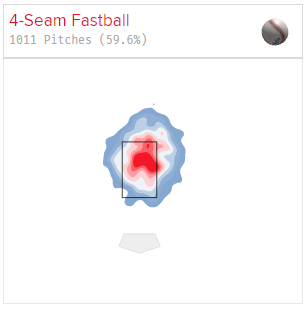
There are a lot of middle-middle fastballs in that picture. Like most pitchers, he throws it most often when he’s behind in the count and needs a strike. After all, he doesn’t walk many batters. The problem is that a 92 mph fastball down the pipe is just about the most hittable pitch in baseball, especially from a lefty pitcher to a righty batter. When opposing right-handed hitters are ahead in the count, they hit .448 on his fastball with a .828 slugging percentage.
The coaching staff may want to encourage him to mix up his pitches more. His curveball and changeup get better results, so maybe decreasing his overall fastball usage in favor of his secondaries will improve his numbers. They can also ask him to “pitch backward” more often— throwing curves and changeups in fastball counts. This may lead to more walks, but if the tradeoff is fewer loud hits, it will be worthwhile.
Finding a Role for Heaney
We’ve seen the Andrew Heaney movie before. The Yankees have a habit of trading for middling lefty starting pitchers at the deadline, such as J.A. Happ and Jaime García. The problem this time is that it’s not clear Heaney is a rotation upgrade over their current starters. Before the trade, their rotation was Gerrit Cole, Jameson Taillon, Jordan Montgomery, Domingo Germán, and Nestor Cortes. The first three have guaranteed starting spots. Germán has been up and down this season, including a stint in the bullpen, with overall numbers similar to those of Heaney. Cortes has been a revelation, pitching inexplicably well in a variety of roles.
If not for the fact that they just traded for him as a starter, Heaney would probably be the best choice to take a lesser role. That’s not an option right now, so Germán would seem like the obvious choice to move to the bullpen to make way for Heaney, but it appears Cortes gets the boot. That deepens their relief corps but weakens their rotation. Hopefully, Corey Kluber and Luis Severino will be back soon and make it all a moot point.
The Yankees made it a priority to add depth to their starting rotation. Injuries to their major league and triple-A rosters diminished what was thought to be a strength in Spring Training. Heaney certainly gives them more options should another pitcher land on the IL. He’s probably better than his ERA indicates, but not by much, and it’s not clear he’s among their five best starting pitchers right now. He’ll reach free agency following the season, so the club has two months to get the best out of him and justify handing him the ball every fifth day.
The post Meet Andrew Heaney, the Yankees’ new starting pitcher appeared first on Bronx Pinstripes | BronxPinstripes.com.
]]>The post Are the 2021 Yankees as bad as the 2013 Yankees? appeared first on Bronx Pinstripes | BronxPinstripes.com.
]]>For this exercise, I am not paying attention to expectations. For example, the 2013 Yankees obviously had lower expectations than the 2021 Yankees. I am simply comparing the stats. Additionally, everything below is looking at the time period from 2013 to 2021.
If you remember (or maybe you’ve completely blocked it out of your memory), the 2013 team featured superstars such as Travis Hafner, Ben Francisco, Lyle Overbay, and the like. The only position player of significance was Robinson Cano.
Batting
Here are the standard stats:
Of course, batting average is not extremely meaningful, but this year’s team has the lowest batting average since 2013 at .236.
Looking at some more advanced stats, we can see that even though the ’21 team has been league-average when it comes to wRC+, the 2013 team was very poor at 86. The following year was also below average at 94, as was 2016 when the mark was 92. So each year they’ve missed the playoffs in the last eight seasons, they’ve had a below-average wRC+. The more recent teams (since 2018) have also had walk rates above 10 percent outside of 2019. Earlier in the decade, this number was also below 10 percent.
The 2021 team’s SLG and ISO are also way down at .397 and .161, respectfully. Their slugging has not been that bad since the 2013-2014 non-playoff teams, and their ISO hasn’t been that bad since the 2016 non-playoff team.
Another unfortunate stat? This year’s team has a groundball-to-flyball rate of 1.27 — the same as last season. Other than those two times, the only other time that rate was over was 2013 (1.24), 2014 (1.25), and 2016 (1.32). All other times it was no higher than 1.16. This means that we have been really pounding the ball into the ground, which explains the extremely high amount of double plays. As a team that typically is built to hit many home runs, if you are hitting a lot more grounders than fly balls, it’s not a great sign. The Yankees lead the league, by the way, by grounding into 0.98 double plays per game. The Rays are last, grounding into only 0.42 per game.
And just for fun, let’s take a look at with runners in scoring position:
This year’s 82 wRC+ with runners in scoring position would easily be the worst mark from 2013-2021 if not for the 2016 Yankees. Once again, the only teams to not be above average in terms of wRC+ with runners in scoring position were the 2013, 2014, and 2016 teams, all of who did not make the postseason.
Pitching
On the pitching side, things are actually going pretty well. Batting average for opponents against Yankees pitching is the lowest it’s been during this period at .226. And the 3.78 ERA is significantly better than 4.31 and 4.35 in 2019 and 2020, respectively.
And while their best relievers have all had massive meltdowns over the past few weeks, their ERA from the sixth inning onwards is third-best during this span.
All in all, these numbers are not great signs of things to come. Then again, we’re not even into August yet, and again they are only two games back in the loss column in the Wild Card. The trade deadline is coming up fast, tomorrow at 4 p.m. ET. So far, the Yankees have been quiet outside of trading Luis Cessa and Justin Wilson to the Reds, although a trade for Joey Gallo is pending. They will need to make more moves to boost the team, otherwise, they could be looking at a similar fate to 2013, 2014, and 2016.
The post Are the 2021 Yankees as bad as the 2013 Yankees? appeared first on Bronx Pinstripes | BronxPinstripes.com.
]]>